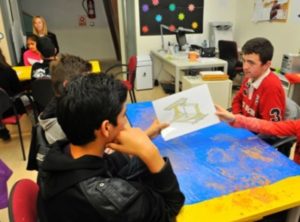
Mudejar art is the most characteristic artistic expression of our city, both for its abundance and its artistic value.
Its study can be approached from many points of view, artistic, historical, but with this workshop, we will make an approach to Mudejar art from Mathematics, and more specifically from Plane Geometry, without neglecting history and aesthetics.
The objective is not to conduct a theoretical study on Geometry but to learn to identify certain geometric structures in Mudejar decoration, an essential principle of this artistic manifestation, and once identified, be able to manipulate and interpret them. In this way, we will be able to connect art with other disciplines and appreciate Geometry expressively and aesthetically.
The workshops are aimed at students aged 3-18, differentiating the content by educational stages. . For their development, the contents of the school curriculum have been taken into account, so that they complement the activities carried out in the educational centre.
Pre-school level
Through a playful, participatory, and didactic atmosphere, we will introduce students to the knowledge of Mudejar Art, considering that the basis of its decoration is mathematics and more specifically geometry.
First, we will work on basic flat geometric shapes that appear in our everyday context. Guided, children will identify the flat geometric shapes they know in a series of everyday objects, which we will call treasures.
Next, after analyzing the decoration of the Mudéjar Tower of Saint Peter and identifying the flat geometric shapes it contains, we will build a particular Mudéjar tower using these shapes. Each child will also build their own tower using school materials.
Elementary school level.
Considering that the basis of Mudejar decoration is Geometry and using play as the main learning inducer, students will explore and interpret Mudejar Art through this branch of Mathematics.
By manipulating different geometric shapes, each child will build a Mudejar star, which will be used to understand one of the decorative resources used by the Mudéjars: friezes.
To conclude the activity, each child will put into practice the knowledge acquired and will create four friezes found in our Mudéjar Ensemble of Saint Peter.
Secondary school level
Using group work as an effective method of learning, we will approach Mudejar decoration from one of its fundamental principles, mathematics, and more specifically from Geometry.
Through various isometric transformations, students will create friezes that appear in Mudejar Art. Subsequently, they will identify these works in the Mudéjar Towers of Teruel. This strategy will allow them to understand the interaction between Art and Mathematics in this Artistic manifestation.
